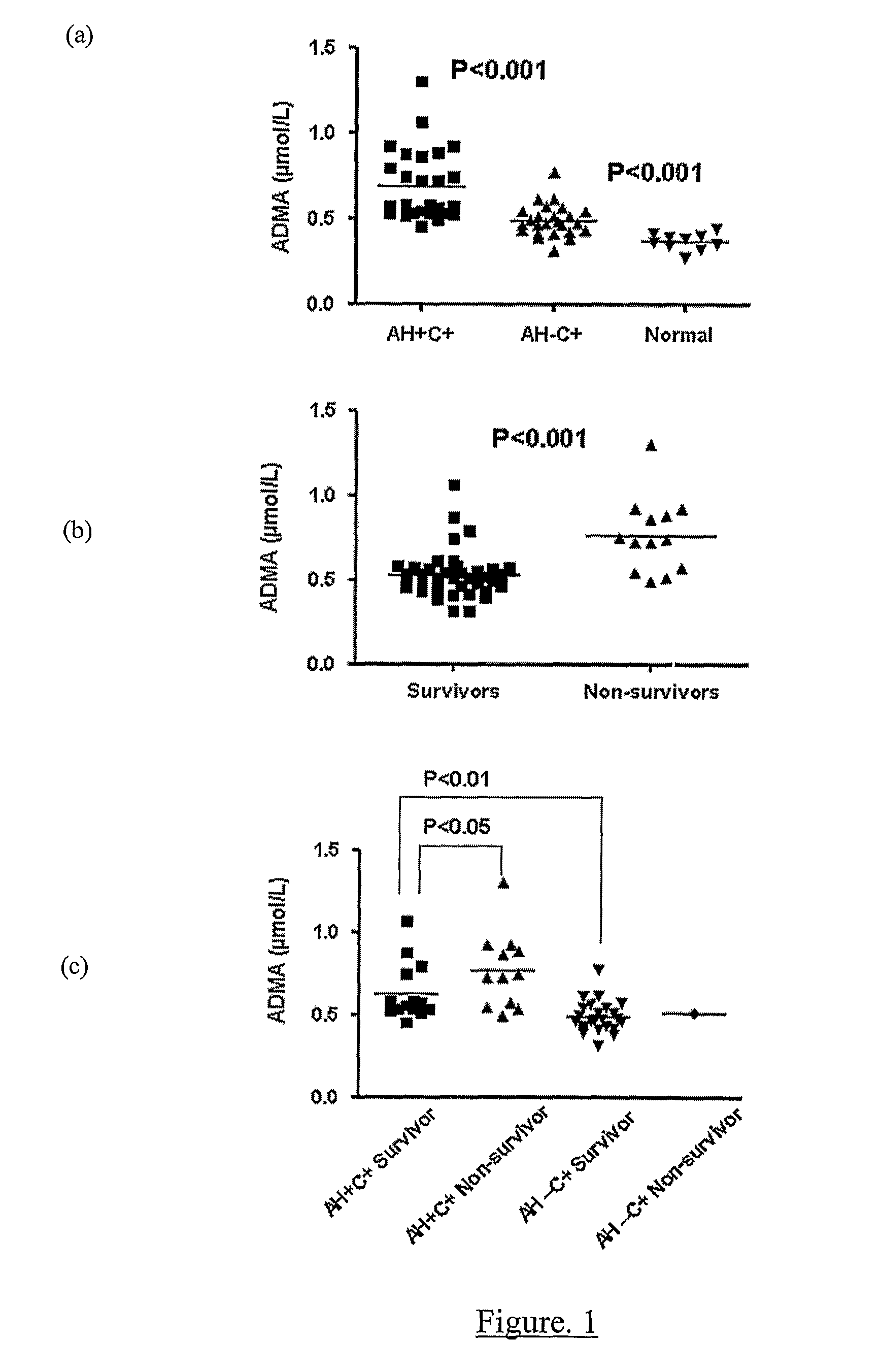Biomarkers for assessing liver function
a liver function and biomarker technology, applied in the field of liver function assessment, can solve the problems of high incidence of organ failure and sepsis, and achieve the effect of improving the predictive utility of poor outcome and excellent predictive utility to assess
- Summary
- Abstract
- Description
- Claims
- Application Information
AI Technical Summary
Benefits of technology
Problems solved by technology
Method used
Image
Examples
example 1
Increasing Dimethylarginine Levels are Associated with Adverse Clinical Outcome in Severe Alcoholic Hepatitis
Methods
[0112]Study Design All patients or their relatives gave written informed consent or assent, respectively, in accordance with the Declaration of Helsinki of the World Medical Association, 1989, and the study was approved by the local ethics committee. Patients were included with evidence of an acute decompensation of alcoholic liver disease (increasing ascites, pedal oedema or progressive jaundice) with clinical and radiological evidence of cirrhosis, and with a current history of alcohol abuse (alcohol consumption of >80 g alcohol / day for men and >60 g / day for women up until the time of admission). Patients were excluded if they were 75 years and had evidence of: additional or another aetiology of liver disease; severe cardiac dysfunction or renal failure (creatinine>150 μmol / L); hepatic / extra-hepatic malignancy; hepatic encephalopathy≧Grade 2 (precluding informed cons...
example 2
Patients Who Die of Alcoholic Liver Disease have a Significantly Increased IMA:Albumin Ratio
Methods
[0139]Method of assessment for an IMA:albumin ratio: Abbott Aeroset Bromocresol Purple (BCP) test is used for the measurement of serum albumin (Duly et al; J Clin Pathol 2003). The concentration of ischemia modified serum albumin can be determined by the addition of a known amount of Co(II) to a serum specimen and measurement of the unbound Co(II) by a colorimetric assay using dithiothreitol (DTT) (Bhagavan, N V; Clin Chem 2003 and Bar-Or D; Eur J Biochem 2001). An inverse relationship thus exists between the amount of albumin bound cobalt and the intensity of the colour formation. In brief: All reactions are carried out in 1.5 ml Eppendorfs at room temperature. 200 μL of patient serum is added to 50 μL of a solution of 1 g / L of cobalt chloride, followed by vigorous mixing, and a 10 minute incubation. DTT (50 μL of a 1.5 g / L solution) is then added and mixed. After a 2-min incubation, ...
example 3
IMAR, DAS and DASIMAR to Predict Survival in a Rodent Liver Failure Model
[0142]Rats were treated with an agent known to cause liver injury, galactosamine (Sigma, Poole UK), by intra-peritoneal injection (IP) at 1 g / kg (n=22) followed 24 hours later by a further challenge in a subgroup with lipopolysaccharide (LPS—Klebsiella pneumonia, n=11) to simulate additional infection / inflammation administered IP at 1 mg / kg. Blood samples were then obtained immediately prior to death.
[0143]Those animals receiving the challenge at 24 hours all incurred mortality by 6 hours, as compared to rats receiving galactosamine alone or sham animals which received a similar dose of LPS.
[0144]Measures of ADMA, SDMA, and IMAR were taken using the same methods described in the previous Examples. As with the data from human patients, it was seen that DASIMAR is a much better predictor of mortality (AUROC of 0.96) than DAS or IMAR alone (see FIG. 11). Indeed, in this model, DASIMAR has a high sensitivity (96%) ...
PUM
 Login to View More
Login to View More Abstract
Description
Claims
Application Information
 Login to View More
Login to View More - R&D
- Intellectual Property
- Life Sciences
- Materials
- Tech Scout
- Unparalleled Data Quality
- Higher Quality Content
- 60% Fewer Hallucinations
Browse by: Latest US Patents, China's latest patents, Technical Efficacy Thesaurus, Application Domain, Technology Topic, Popular Technical Reports.
© 2025 PatSnap. All rights reserved.Legal|Privacy policy|Modern Slavery Act Transparency Statement|Sitemap|About US| Contact US: help@patsnap.com



